Thermo Fisher Scientific RapidFinder Specific Tuna ID Kit Mode d'emploi
- Taper
- Mode d'emploi

For testing of Food and Environmental samples only.
RapidFinder™ Specific Tuna ID Kit
USER GUIDE
Real-time PCR detection of specific tuna DNA in food and feed
samples
for use with:
Applied Biosystems™ QuantStudio™ 5 Real‑Time PCR Instrument with Thermo
Scientific™ RapidFinder™ Analysis Software v2.0 or later
Applied Biosystems™ 7500 Fast Real‑Time PCR Instrument with Applied
Biosystems™ RapidFinder™ Express Software v2.0 or later
Catalog NumberA24411
Publication NumberMAN0018299
Revision B.0

Health in Code S.L., Calle de la Travesia s/n, 15E Base 5, Valencia 46024, Spain
For descriptions of symbols on product labels or product documents, go to thermofisher.com/symbols-definition.
Revision history:Pub.No.MAN0018299
Revision Date Description
B.0 31 May 2023
•The manufacturer address was updated.
•The trademark statement was updated.
•The Kit sensitivity and specificity table was updated.
•The storage temperature for the General Master Mix was updated.
•The RapidFinder™ Analysis Software version was updated.
A.0 1 June 2021 New document converted from Imegen document for the RapidFinder™ Specific Tuna ID Kit.
The information in this guide is subject to change without notice.
DISCLAIMER: TO THE EXTENT ALLOWED BY LAW, THERMO FISHER SCIENTIFIC INC. AND/OR ITS AFFILIATE(S) WILL NOT BE
LIABLE FOR SPECIAL, INCIDENTAL, INDIRECT, PUNITIVE, MULTIPLE, OR CONSEQUENTIAL DAMAGES IN CONNECTION WITH OR
ARISING FROM THIS DOCUMENT, INCLUDING YOUR USE OF IT.
Trademarks: All trademarks are the property of Thermo Fisher Scientific and its subsidiaries unless otherwise specified. TaqMan is a
trademark of Roche Molecular Systems, Inc., used under permission and license. Imegen agro is a trademark of Health in Code SL.
©2023 Thermo Fisher Scientific Inc. All rights reserved.

Contents
■CHAPTER1Productinformation .................................................. 5
Productdescription ............................................................. 5
Kit contents and storage ......................................................... 6
Materials required but not provided ................................................ 6
■CHAPTER2Methods ............................................................... 8
Input DNA requirements ......................................................... 8
Determine the number of reactions, then thaw the reagents .......................... 8
Set up the PCR reactions ........................................................ 8
Set up and run the real-time PCRinstrument ....................................... 9
Analyze results ................................................................ 10
Interpretation of results ......................................................... 11
■APPENDIXATroubleshooting .................................................... 12
■APPENDIXBSupplementalinformation ........................................ 14
Kit sensitivity andspecificity ..................................................... 14
UNE‑EN ISO 9001certification ................................................... 16
UNE‑EN ISO 14001certification ................................................. 16
■APPENDIXCGood laboratory practices forPCR .............................. 17
Plate layoutsuggestions ........................................................ 17
■APPENDIXDSafety ............................................................... 18
Chemicalsafety ................................................................ 19
Biological hazardsafety ......................................................... 20
RapidFinder™ Specific Tuna ID Kit User Guide 3

■APPENDIXEDocumentation and support ...................................... 21
Food safety support ............................................................ 21
Customer and technical support ................................................. 21
Relateddocumentation ......................................................... 22
Limited product warranty ........................................................ 22
Contents
4RapidFinder™ Specific Tuna ID Kit User Guide

Product information
IMPORTANT! Before using this product, read and understand the information in the “Safety” appendix
in this document.
Product description
Identification of meat species present in food samples is an essential step for verification of origin
and traceability of raw materials, as well as for quality control of handling and cleaning processes
in production lines. The Thermo Scientific™ RapidFinder™ Specific Tuna ID Kit enables real-time PCR
detection of specific tuna DNA that is present in food and feed samples. The kit detects blends
containing ≥ 1% of the following tuna species through the specific amplification of a specific region
present in the mitochondrial genome.
•Thunnus alalunga (Longfin tuna)
•Thunnus albacares (Yellowfin tuna)
•Thunnus obesus (Bigeye tuna)
•Katsuwonus pelamis (Skipjack tuna)
The kit includes:
•Master Mix Tuna 1—Contains FAM™- and VIC™-labeled probes and primers to detect Thunnus
alalunga and Thunnus albacares mitochondrial DNA.
•Master Mix Tuna 2—Contains FAM™- and VIC™-labeled probes and primers to detect Thunnus
obesus and Katsuwonus pelamis mitochondrial DNA.
•Positive Control Tuna 1—A positive control to confirm detection of Thunnus alalunga / Thunnus
albacares mitochondrial DNA.
•Positive Control Tuna 2—A positive control to confirm detection of Thunnus obesus / Katsuwonus
pelamis mitochondrial DNA.
•General Master Mix—Contains a DNA polymerase enzyme, dNTPs, and other buer components.
•An internal positive control (IPC)—Cy5™-labeled probe, primers, and template, to monitor for PCR
inhibition (included in the reagents).
Unknown samples and control samples are provided by the investigator.
1
RapidFinder™ Specific Tuna ID Kit User Guide 5

Kit contents and storage
Table1RapidFinder™ Specific Tuna ID Kit (Cat. No.A24411)
Component Amount (48 reactions) Storage[1]
Master Mix Tuna 1 (purple pad) 360 µL –20°C
Master Mix Tuna 2 (yellow pad) 360 µL –20°C
General Master Mix (white pad) 2 x 600 µL –20°C upon receipt.
2–8°C after initial use.
Store protected from
light.
Positive Control Tuna 1 (1%) (purple cap) 60µL –20°C
Positive Control Tuna 2 (1%) (yellow cap) 60µL –20°C
[1] Refer to the expiration date on the box.
Materials required but not provided
Unless otherwise indicated, all materials are available through the Thermo Fisher Microbiology
ordering process or thermofisher.com. They may also be available through Fisher Scientific
(fisherscientific.com), MLS, or another major laboratory supplier.
Catalog numbers that appear as links open the web pages for those products.
Item Source
Real-time PCR instrument, one of the following:
Applied Biosystems™ QuantStudio™ 5 Real‑Time PCR System
Contact your local microbiology sales
representative.
Applied Biosystems™ 7500 Fast Real-Time PCR System
Equipment
KingFisher™mLPurification System 5400050
Adjustable micropipettors (10µL, 20µL, 200µL)
Available through the Thermo Fisher
Microbiology ordering process. See
thermofisher.com/plastics for more
information.
Benchtop microcentrifuge with adaptors for PCR plates and/or
tubes
Laboratory mixer (Vortex mixer or equivalent)
Optical reaction plates and covers, or optical PCR tubes and caps
MicroAmp™ Fast Optical 96-Well Reaction Plate, 0.1 mL 4346907
MicroAmp™ Optical Adhesive Film, 100 covers 4311971
Chapter1Product information
Kit contents and storage
1
6RapidFinder™ Specific Tuna ID Kit User Guide

(continued)
Item Source
MicroAmp™ Fast 8-Tube Strip, 0.1mL (See below for caps.) 4358293
MicroAmp™ Optical 8-Cap Strips 4323032
Other plastics and consumables
Aerosol-resistant pipette tips Available through the Thermo Fisher
Microbiology ordering process. See
thermofisher.com/plastics for more
information.
1.5-mL nuclease-free microcentrifuge tubes
Powder-free disposable gloves
Reagents
Nuclease-free water (not DEPC-Treated) AM9938
Recommended kits for DNA isolation, one of the following:
GMO Extraction Kit 4466336
For high-throughput isolation:
Lysis Buer 1 + RNase GMO Extraction Kit
PrepSEQ™ Nucleic Acid Extraction Kit
A24401
4428176, 4480466
Chapter1Product information
Materials required but not provided 1
RapidFinder™ Specific Tuna ID Kit User Guide 7

Methods
Input DNA requirements
•Prepare the DNA sample with a method that allows processing of 10–20g of food sample.
–For low-throughput, manual processing, use the GMO Extraction Kit.
–For automated processing, use Lysis Buer 1 + RNase GMO Extraction Kit and the PrepSEQ™
Nucleic Acid Extraction Kit with the KingFisher™mLPurification System.
•Prepare at least one mock-purified sample as a negative extraction control, processed with the
same DNA isolation method that is used for test samples.
•Dilute the final DNA sample to 10ng/µL for the PCR.
Determine the number of reactions, then thaw the reagents
1. Plan to include the following reactions.
•Single reaction for each test sample
•Single reaction for each of the following controls:
–Positive Control (included in the kit).
–Negative extraction control (mock-purified samples).
–No-template control reactions; use nuclease-free water in place of sample DNA.
2. Thaw all reagents, vortex to mix thoroughly, then place on ice.
Set up the PCR reactions
1. Prepare two separate PCR reaction mixes by combining the following components for the number
of reactions required plus 10% overage.
Table2Master Mix Tuna 1
Component Volume per reaction
Master Mix Tuna 1 (purple pad) 7.5 µL
General Master Mix (white pad) 12.5 µL
2
8RapidFinder™ Specific Tuna ID Kit User Guide

Table3Master Mix Tuna 2
Component Volume per reaction
Master Mix Tuna 2 (yellow pad) 7.5 µL
General Master Mix (white pad) 12.5 µL
2. Mix thoroughly by vortexing, then distribute 20 µL to each reaction well or tube.
3. Add 5µL of DNA sample (10ng/µL), mock-purified sample (negative extraction control), nuclease-
free water (no-template control), or Positive Control to the appropriate wells.
4. Seal each plate or tube, mix, then centrifuge briefly to bring the contents to the bottom.
Set up and run the real-time PCR instrument
1. See the appropriate instrument user guide for detailed instructions to set up and run the real-time
PCR instrument.
•Reaction volume: 25 µL
•Passive reference dye: ROX™ dye included
•TaqMan™ probe reporter dyes and quenchers:
Target Reporter Quencher
T. alalunga & T. obesus FAM™ dye NFQ-MGB
T. albacares & K. pelamis VIC™ dye NFQ-MGB
IPC Cy5™ dye None
•Thermal cycler settings:
Setting Stage 1
Enzyme activation
Stage 2
PCR
Number of cycles 1 (Hold) 36
Denature Anneal/extend[1]
Temperature 95°C 95°C 60°C
Time 10 minutes 15 seconds 1 minute
[1] Fluorescence is acquired during the annealing/extension stage.
2. Load the reactions, run the thermal cycler program and collect real-time amplification data.
Chapter2Methods
Set up and run the real-time PCR instrument 2
RapidFinder™ Specific Tuna ID Kit User Guide 9

Analyze results
The general process for analyzing results is described in this section. The details of data analysis
depend on the real-time PCR instrument that you use; refer to the appropriate user guide for
instructions on how to analyze your data.
1. View the amplification plots for all reactions to make sure that they appear normal.
2. Use the Auto instrument setting to set the baseline.
3. Set the FAM™ , VIC™ and Cy5™ threshold to 0.2.
4. Check that the results obtained in all control wells are as expected:
Reaction type
FAM™ channel
(T. alalunga &
T. obesus)
VIC™ channel
(T. albacares &
K. pelamis)
Cy5™
channel
(IPC)[1]
Positive Control + + +
Negative extraction control — — +
No-template control — — +
[1] In all reactions, the Ct of the IPC should be similar to the Ct of the Positive Control.
For unexpected control results, refer to the troubleshooting section of this guide.
5. Establish the positive cut-o value for the test samples and assign results:
Ct (cut-o) = Ct Positive Control (1%)
Sample Ct value Sample result
Ct > Ct (cut-o) Negative
Ct ≤ Ct (cut-o) Positive[1]
[1] For fresh or minimally processed meat samples, the cut-off value corresponds to approximately 1% specific tuna DNA, when
the DNA sample concentration is 10ng/µL.
Chapter2Methods
Analyze results
2
10 RapidFinder™ Specific Tuna ID Kit User Guide

Interpretation of results
Interpret unknown sample results according to the following table.
FAM™ channel
(T .alalunga &
T. obesus)
VIC™ channel
(T. albacares &
K. pelamis)
Cy5™ channel
(IPC)
Interpretation
— + Tuna DNA not detected.
+ + Tuna DNA detected.
— — Invalid result. See AppendixA,
“Troubleshooting”.
+ — This result is expected in reactions that
have strong FAM™ and VIC™signals. See
Appendix A, “Troubleshooting”.
Chapter2Methods
Interpretation of results 2
RapidFinder™ Specific Tuna ID Kit User Guide 11

Troubleshooting
Observation Possible cause Recommended action
In the Positive Control wells,
no target-specific and no IPC
signals are detected.
PCR amplification failed. Check that the thermal cycler settings and
amplification program are correct.
In the negative extraction
control wells, target-specific
and IPC signals are detected.
Contamination occurred during
the DNA extraction procedure.
Contamination may be due to errors in
sample handling, reagent contamination, or
environmental contamination.
•Check that the DNA extraction protocol
was performed correctly.
•Take care to avoid contamination during
sample homogenization: decontaminate
grinding equipment or homogenizer with
10%bleach or DNAZap™ Solutions (Cat.
No.AM9890).
•Decontaminate benchtop surfaces and
other equipment where the DNA
extraction process is performed with
10%bleach or DNAZap™ Solutions.
•If necessary, use fresh reagents and
repeat the DNA extraction.
In the no-template control
wells, target-specific and IPC
signals are detected.
Contamination occurred during
PCR.
Contamination may be due to errors in
sample handling, reagent contamination, or
environmental contamination.
•Decontaminate benchtop surfaces and
other equipment where PCR is performed
with 10%bleach or DNAZap™Solutions
(Cat. No. AM9890).
•Use fresh reagents and repeat the PCR.
•Set up the Positive Control PCR reactions
last to avoid cross-contamination.
In unknown wells, no IPC
signal is detected, but target-
specific signal is detected.
A high copy number of
target DNA existed in
the samples, resulting in
preferential amplification of the
target-specific DNA.
No action is required. The result is considered
positive.
In unknown wells, no IPC
or target-specific signal is
detected.
Excess sample DNA was used
in PCR; the recommended
maximum is 250ng.
Repeat the PCR with the correct amount of
DNA. If DNA quantification is not possible,
dilute the DNA sample.
A
12 RapidFinder™ Specific Tuna ID Kit User Guide

Observation Possible cause Recommended action
In unknown wells, no IPC
or target-specific signal is
detected.
(continued)
PCR inhibitors were present in
the sample DNA.
Repeat the DNA extraction. If the problem
persists, contact Technical Support.
AppendixATroubleshooting
Interpretation of results A
RapidFinder™ Specific Tuna ID Kit User Guide 13

Supplemental information
Kit sensitivity and specificity
The detection limit was calculated with standard samples consisting of mixtures of raw specific tuna
meat and other species. The RapidFinder™ Specific Tuna ID Kit can detect blends with as little as
1% (w/w) of specific tuna meat. The limit of detection in processed samples varies depending on the
composition and food processing.
The kit specificity was tested by comparison of the probe and primer sequences with the NCBI
database, and it was also experimentally tested on a collection of reference DNAs, with the following
results:
Table4Master Mix Tuna 1 (Thunnus alalunga / Thunnus albacares)
Species Result
Longfin tuna (Thunnus alalunga) Detected
Yellowfin tuna (Thunnus albacares) Detected
Bigeye tuna (Thunnus obesus) Not Detected
Skipjack tuna (Katsuwonus pelamis) Not Detected
Atlantic bluefin tuna (Thunnus thynnus) Not Detected
Clam (Ruditapes decussatus) Not Detected
Crab (Cancer pagurus) Not Detected
European crayfish (Astacus astacus) Not Detected
Prawn (Aristaeomorpha foliacea) Not Detected
Octopus (Octopus vulgaris) Not Detected
Cuttlefish (Sepia ocinalis) Not Detected
European eel (Anguilla anguilla) Not Detected
Dab (Limanda limanda) Not Detected
European bass (Dicentrarchus labrax) Not Detected
Sole (Solea solea) Not Detected
Atlantic cod (Gadus morhua) Not Detected
European hake (Merluccius merluccius) Not Detected
B
14 RapidFinder™ Specific Tuna ID Kit User Guide

Table 4 Master Mix Tuna 1 (Thunnus alalunga / Thunnus albacares)(continued)
Species Result
European pilchard (Sardina pilchardus) Not Detected
Angler (Lophius piscatorius) Not Detected
Brown trout (Salmo trutta) Not Detected
Swordfish (Xiphias gladius) Not Detected
Beef (Bos taurus) Not Detected
Pork (Sus scrofa domestica) Not Detected
Horse (Equus caballus) Not Detected
Goat (Capra aegagrus hircus) Not Detected
Sheep (Ovis aries) Not Detected
Table5Master Mix Tuna 2 (Thunnus obesus / Katsuwonus pelamis)
Species Result
Longfin tuna (Thunnus alalunga) Not Detected
Yellowfin tuna (Thunnus albacares) Not Detected
Bigeye tuna (Thunnus obesus) Detected
Skipjack tuna (Katsuwonus pelamis) Detected
Atlantic bluefin tuna (Thunnus thynnus)[1] Detected
Clam (Ruditapes decussatus) Not Detected
Crab (Cancer pagurus) Not Detected
European crayfish (Astacus astacus) Not Detected
Prawn (Aristaeomorpha foliacea) Not Detected
Octopus (Octopus vulgaris) Not Detected
Cuttlefish (Sepia ocinalis) Not Detected
European eel (Anguilla anguilla) Not Detected
Dab (Limanda limanda) Not Detected
European bass (Dicentrarchus labrax) Not Detected
Sole (Solea solea) Not Detected
Atlantic cod (Gadus morhua) Not Detected
European hake (Merluccius merluccius) Not Detected
AppendixBSupplemental information
Kit sensitivity and specificity B
RapidFinder™ Specific Tuna ID Kit User Guide 15

Table 5 Master Mix Tuna 2 (Thunnus obesus / Katsuwonus pelamis)(continued)
Species Result
European pilchard (Sardina pilchardus) Not Detected
Angler (Lophius piscatorius) Not Detected
Brown trout (Salmo trutta) Not Detected
Swordfish (Xiphias gladius) Not Detected
Beef (Bos taurus) Not Detected
Pork (Sus scrofa domestica) Not Detected
Horse (Equus caballus) Not Detected
Goat (Capra aegagrus hircus) Not Detected
Sheep (Ovis aries) Not Detected
[1] The T. obesus amplification systems also amplifies DNA from T. thynnus.
UNE‑EN ISO 9001 certification
Health in Code S.L. is certified against the standard UNE-EN ISO 9001:2015 "Quality management
systems" for the design, development, manufacture, and commercialization of kits for genetic analysis.
UNE‑EN ISO 14001 certification
Health in Code S.L. is certified against the standard UNE-EN ISO 14001:2015 “Environmental
Management Systems” for the design, development, manufacture, and commercialization of kits for
genetic analysis.
AppendixBSupplemental information
UNE‑EN ISO 9001 certification
B
16 RapidFinder™ Specific Tuna ID Kit User Guide

Good laboratory practices for PCR
Note: Spin tubes/plates before performing PCR. Spinning of PCR tubes is most easily accomplished
by using a centrifuge designed for PCR tubes or plates. Follow manufacturer instructions for loading
tubes/plates.
To avoid amplicon contamination of samples, follow these guidelines when preparing or handling
samples for PCR amplification:
•Wear clean gloves and a clean lab coat (not previously worn while handling amplified products or
used during sample preparation).
•Change gloves whenever you suspect that they are contaminated.
•Maintain separate areas and dedicated equipment and supplies for:
–Sample preparation and reaction setup.
–Amplification and analysis of products.
•Do not bring amplified products into the reaction setup area.
•Open and close all sample tubes carefully. Avoid splashing or spraying samples.
•Keep reactions and components capped as much as possible.
•Use a positive-displacement pipettor or aerosol-resistant barrier pipette tips.
•Do not open reaction tubes after PCR.
•Do not autoclave reaction tubes after PCR.
•Clean lab benches and equipment periodically with 10% bleach solution or DNAZap™ Solutions
(Cat. No.AM9890) according to the Thermo Fisher Scientific PCR Decontamination Protocol. After
cleaning with bleach we recommend a rinse with distilled water or an ethanol solution because
bleach will rust stainless steel. Note that minor discoloration of metal parts may occur.
For additional information, refer to EN ISO 22174:2005 or www.thermofisher.com/us/en/home/life-
science/pcr/real-time-learning-center/real-time-pcr-basics.html.
Plate layout suggestions
•Separate dierent targets by a row if enough space is available.
•Put at least one well between unknown samples and controls if possible.
•Separate negative and positive controls by one well if possible.
•Place replicates of one sample for the same target next to each other.
•Start with the unknown samples and put controls at the end of the row or column.
•Put positive controls in one of the outer rows or columns if possible.
•Consider that caps for PCR tubes come in strips of 8 or 12.
C
RapidFinder™ Specific Tuna ID Kit User Guide 17

Safety
WARNING! GENERAL SAFETY. Using this product in a manner not specified in the user
documentation may result in personal injury or damage to the instrument or device. Ensure that
anyone using this product has received instructions in general safety practices for laboratories and
the safety information provided in this document.
·Before using an instrument or device, read and understand the safety information provided in the
user documentation provided by the manufacturer of the instrument or device.
·Before handling chemicals, read and understand all applicable Safety Data Sheets (SDSs) and use
appropriate personal protective equipment (gloves, gowns, eye protection, and so on). To obtain
SDSs, visit thermofisher.com/support.
D
18 RapidFinder™ Specific Tuna ID Kit User Guide

Chemical safety
WARNING! GENERAL CHEMICAL HANDLING. To minimize hazards, ensure laboratory personnel
read and practice the general safety guidelines for chemical usage, storage, and waste provided
below. Consult the relevant SDS for specific precautions and instructions:
·Read and understand the Safety Data Sheets (SDSs) provided by the chemical manufacturer
before you store, handle, or work with any chemicals or hazardous materials. To obtain SDSs, see
the "Documentation and Support" section in this document.
·Minimize contact with chemicals. Wear appropriate personal protective equipment when handling
chemicals (for example, safety glasses, gloves, or protective clothing).
·Minimize the inhalation of chemicals. Do not leave chemical containers open. Use only with
sucient ventilation (for example, fume hood).
·Check regularly for chemical leaks or spills. If a leak or spill occurs, follow the manufacturer
cleanup procedures as recommended in the SDS.
·Handle chemical wastes in a fume hood.
·Ensure use of primary and secondary waste containers. (A primary waste container holds the
immediate waste. A secondary container contains spills or leaks from the primary container.
Both containers must be compatible with the waste material and meet federal, state, and local
requirements for container storage.)
·After emptying a waste container, seal it with the cap provided.
·Characterize (by analysis if needed) the waste generated by the particular applications, reagents,
and substrates used in your laboratory.
·Ensure that the waste is stored, transferred, transported, and disposed of according to all local,
state/provincial, and/or national regulations.
·IMPORTANT! Radioactive or biohazardous materials may require special handling, and disposal
limitations may apply.
WARNING! HAZARDOUS WASTE (from instruments). Waste produced by the instrument is
potentially hazardous. Follow the guidelines noted in the preceding General Chemical Handling
warning.
WARNING! 4L Reagent and Waste Bottle Safety. Four-liter reagent and waste bottles can crack
and leak. Each 4-liter bottle should be secured in a low-density polyethylene safety container with the
cover fastened and the handles locked in the upright position.
AppendixDSafety
Chemical safety D
RapidFinder™ Specific Tuna ID Kit User Guide 19

Biological hazard safety
WARNING! Potential Biohazard. Depending on the samples used on this instrument, the surface
may be considered a biohazard. Use appropriate decontamination methods when working with
biohazards.
WARNING! BIOHAZARD. Biological samples such as tissues, body fluids, infectious agents,
and blood of humans and other animals have the potential to transmit infectious diseases.
Conduct all work in properly equipped facilities with the appropriate safety equipment (for example,
physical containment devices). Safety equipment can also include items for personal protection,
such as gloves, coats, gowns, shoe covers, boots, respirators, face shields, safety glasses, or
goggles. Individuals should be trained according to applicable regulatory and company/ institution
requirements before working with potentially biohazardous materials. Follow all applicable local,
state/provincial, and/or national regulations. The following references provide general guidelines when
handling biological samples in laboratory environment.
·U.S. Department of Health and Human Services, Biosafety in Microbiological and Biomedical
Laboratories (BMBL), 6th Edition, HHS Publication No. (CDC) 300859, Revised June 2020
www.cdc.gov/labs/pdf/CDC-BiosafetymicrobiologicalBiomedicalLaboratories-2020-P.pdf
·Laboratory biosafety manual, fourth edition. Geneva: World Health Organization; 2020 (Laboratory
biosafety manual, fourth edition and associated monographs)
www.who.int/publications/i/item/9789240011311
AppendixDSafety
Biological hazard safety
D
20 RapidFinder™ Specific Tuna ID Kit User Guide
La page est en cours de chargement...
La page est en cours de chargement...
La page est en cours de chargement...
La page est en cours de chargement...
-
 1
1
-
 2
2
-
 3
3
-
 4
4
-
 5
5
-
 6
6
-
 7
7
-
 8
8
-
 9
9
-
 10
10
-
 11
11
-
 12
12
-
 13
13
-
 14
14
-
 15
15
-
 16
16
-
 17
17
-
 18
18
-
 19
19
-
 20
20
-
 21
21
-
 22
22
-
 23
23
-
 24
24
Thermo Fisher Scientific RapidFinder Specific Tuna ID Kit Mode d'emploi
- Taper
- Mode d'emploi
dans d''autres langues
Documents connexes
-
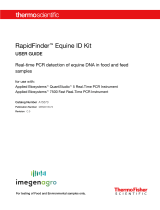 Thermo Fisher Scientific RapidFinder Equine ID Kit Mode d'emploi
Thermo Fisher Scientific RapidFinder Equine ID Kit Mode d'emploi
-
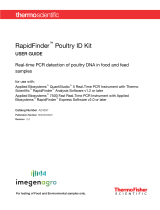 Thermo Fisher Scientific RapidFinder Poultry ID Kit Mode d'emploi
Thermo Fisher Scientific RapidFinder Poultry ID Kit Mode d'emploi
-
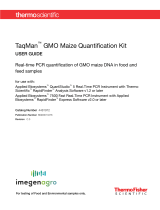 Thermo Fisher Scientific TaqMan GMO Maize Quantification Kit Mode d'emploi
Thermo Fisher Scientific TaqMan GMO Maize Quantification Kit Mode d'emploi
-
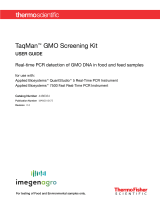 Thermo Fisher Scientific TaqMan GMO Screening Kit Mode d'emploi
Thermo Fisher Scientific TaqMan GMO Screening Kit Mode d'emploi
-
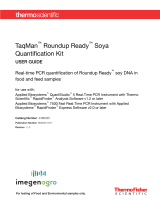 Thermo Fisher Scientific TaqMan Roundup Ready Soya Quantification Kit Mode d'emploi
Thermo Fisher Scientific TaqMan Roundup Ready Soya Quantification Kit Mode d'emploi
-
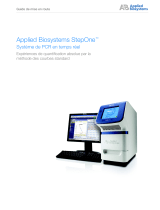 Thermo Fisher Scientific Applied Biosystems StepOne™ Système Le manuel du propriétaire
Thermo Fisher Scientific Applied Biosystems StepOne™ Système Le manuel du propriétaire
-
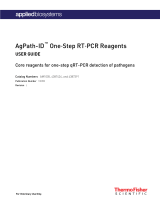 Thermo Fisher Scientific AgPath-ID One Step RT PCR Reagents Mode d'emploi
Thermo Fisher Scientific AgPath-ID One Step RT PCR Reagents Mode d'emploi
-
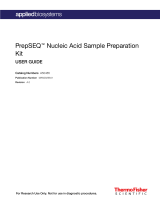 Thermo Fisher Scientific PrepSEQ Nucleic Acid Sample Preparation Kit Mode d'emploi
Thermo Fisher Scientific PrepSEQ Nucleic Acid Sample Preparation Kit Mode d'emploi
-
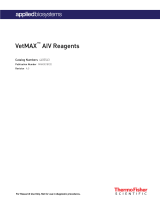 Thermo Fisher Scientific VetMAX AIV Reagents Mode d'emploi
Thermo Fisher Scientific VetMAX AIV Reagents Mode d'emploi
-
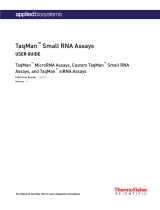 Thermo Fisher Scientific TaqMan Small RNA Assays Mode d'emploi
Thermo Fisher Scientific TaqMan Small RNA Assays Mode d'emploi

































